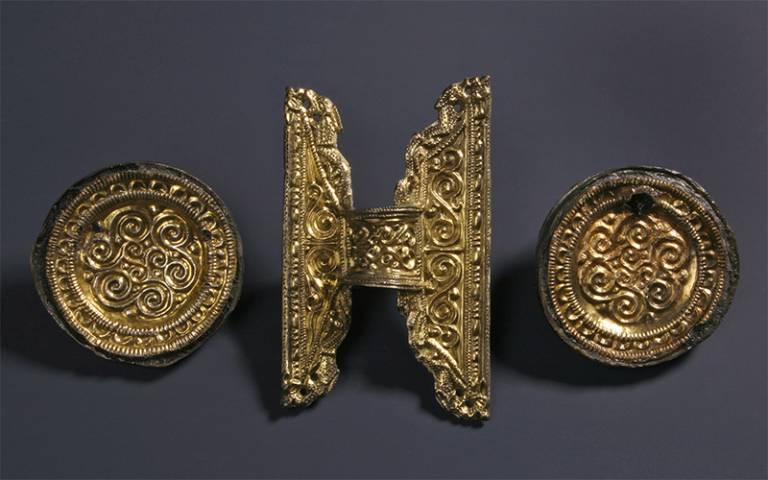People of early medieval England had mostly north-western European heritage
22 September 2022
A genetic and archaeological study involving a UCL researcher has revealed the great extent of migration from continental Europe into the East of England during the early Middle Ages.

In the largest early medieval ancient DNA study to date, an interdisciplinary team consisting of geneticists and archaeologists, led by the Max Planck Institute for Evolutionary Anthropology in Germany, analysed over 400 individuals from ancient Britain, Ireland, Germany, Denmark and the Netherlands. The results, published in Nature, show in detail one of the largest population transformations in the post-Roman world.
Around 300 years after the Romans left Britain, the Venerable Bede wrote about the Angles and the Saxons and their migrations to the British Isles. Scholars of many disciplines, including archaeology, history, linguistics and genetics, have debated what his words might have described, and what the scale, the nature and the impact of human migration was at that time.
For the last 30 years many archaeologists have favoured a view that whilst the cultural impacts of this migration were huge – profoundly changing the language and forms of objects used – the genetic impact would have been minor.
However, new ancient DNA results show that around 75% of the ancestry of people in early medieval Eastern and Southern England (predominantly from the years 450-850 CE) was from continental regions bordering the North Sea - including the Netherlands, Germany and Denmark.
These incomers interbred with the existing population of Britain, but this integration seems to have varied from region to region and community to community.
Co-lead author Joscha Gretzinger (Max Planck Institute for Geoanthropology in Jena, Germany) said: “With 278 ancient genomes from England and hundreds more from Europe, we now gained really fascinating insights into population-scale and individual histories during post-Roman times.
“Not only do we now have an idea of the scale of migration, but also how it played out in communities and families.”
Using published genetic data from more than 4,000 ancient and 10,000 present-day Europeans, the researchers identified subtle genetic differences between the closely related groups inhabiting the ancient North Sea region.
Migrants intermixed with the local population
Upon arrival, the migrants intermixed with the local population to some extent. In one case, in an Anglo-Saxon cemetery from Buckland near Dover, researchers were able to reconstruct a family tree across at least four generations and identify the point in time when migrants and locals intermarried. This family showed a large degree of interaction between the two gene pools. Overall, the researchers witnessed prominent status burials across the studied cemeteries that comprised individuals of both local and migrant origin.
The interdisciplinary team consisting of over 70 authors, including Professor Mark Thomas (UCL Genetics, Evolution & Environment), was able to integrate archaeological data with these new genetic results, which revealed that women of immigrant origin were buried with artifacts more often than women of local origin, especially when considering items such as brooches and beads.
Professor Thomas said: “There has been a number of previous genetics studies trying to establish the scale of migration. Studies based on DNA from people alive today have indicated a substantial migration, but there is no substitute for analysing DNA from people who lived around the time of this formative transition in British history. Earlier ancient DNA studies also indicated substantial migration, but this latest study has so much more power.”
The researchers say that questions remain about how the migrants mixed with indigenous Romano-British people in the generations following the initial migrations.
Co-lead author Professor Duncan Sayer (University of Central Lancashire) said: “We see considerable variation in how this migration affected communities. In some places, we see clear signs of active integration between locals and immigrants, as in the case of Buckland near Dover, or Oakington in Cambridgeshire. Yet in other cases, like Apple Down in West Sussex, we see that people with immigrant and local ancestry were buried separately in the cemetery. Perhaps this is evidence of some degree of social separation at this site.”
Professor Thomas from UCL added: “Understanding how the continental migrants mixed is important because the way they intermarried influenced genetic and cultural patterns in the coming generations. This study is a key step in building a more nuanced understanding of the transition that fundamentally shaped England genetically and culturally today.”
Impact of this historic migration on present-day English people
With the new data, the team could also consider the impact of this historic migration today. Notably the present-day ethnic English derive only 40% of their DNA from these historic continental ancestors, whereas 20 to 40% of their genetic profile likely came from France or Belgium. This genetic component can be seen in the archaeological individuals and in the graves with Frankish objects found in early Medieval graves, particularly in Kent.
Senior author Dr Stephan Schiffels (Max Planck Institute for Evolutionary Anthropology, Leipzig, Germany) said: “It remains unclear whether this additional ancestry related to Iron Age France is connected to a few punctuated migration events, such as the Norman conquest, or whether it was the result of centuries-long mobility across the English Channel.
“Future work, specifically targeting the medieval period and later will reveal the nature of this additional genetic signal.”
Links
- Research paper in Nature
- Professor Mark Thomas’ academic profile
- UCL Centre for Life's Origins & Evolution
- UCL Genetics, Evolution & Environment
- UCL Biosciences
Source
Image
- Grave goods from Issendorf cemetery, Germany. (©Landesmuseum Hannover)
Media contact
Chris Lane
tel: +44 20 7679 9222
E: chris.lane [at] ucl.ac.uk
 Close
Close

